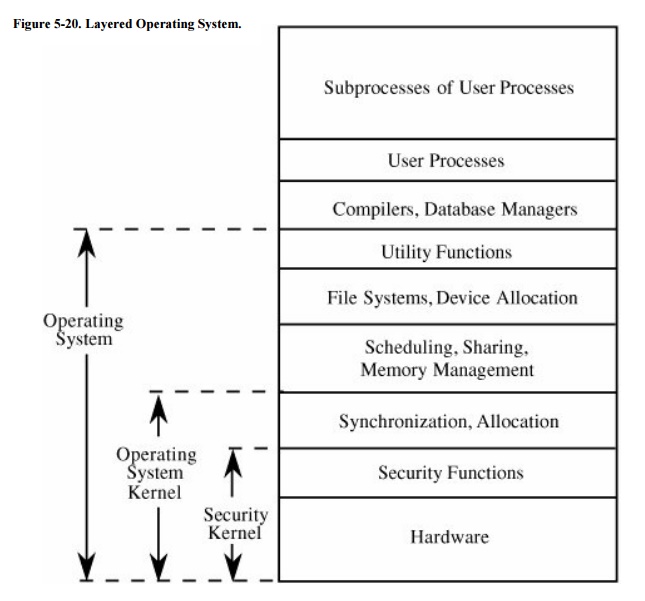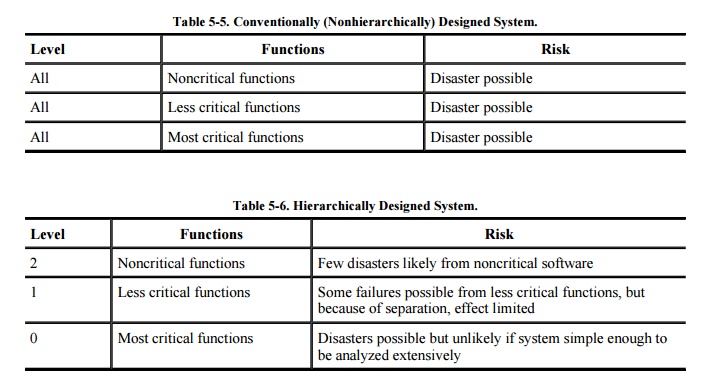Chapter: Security in Computing : Designing Trusted Operating Systems
Layered Design
Layered Design
As described previously, a kernelized operating
system consists of at least four levels: hardware, kernel, operating system,
and user. Each of these layers can include sublayers. For example, in [SCH83b], the kernel has five distinct layers. At
the user level, it is not uncommon to have quasi system programs, such as
database managers or graphical user interface shells, that constitute separate
layers of security themselves.
Layered
Trust
As we have seen earlier in this chapter (in Figure 5-15), the layered view of a secure
operating system can be depicted as a series of concentric circles, with the
most sensitive operations in the innermost layers. Then, the trustworthiness
and access rights of a process can be judged by the process's proximity to the
center: The more trusted processes are closer to the center. But we can also
depict the trusted operating system in layers as a stack, with the security
functions closest to the hardware. Such a system is shown in Figure 5-20.

In this design, some activities related to
protection functions are performed outside the security kernel. For example,
user authentication may include accessing a password table, challenging the
user to supply a password, verifying the correctness of the password, and so
forth. The disadvantage of performing all these operations inside the security
kernel is that some of the operations (such as formatting the userterminal
interaction and searching for the user in a table of known users) do not
warrant high security.
Alternatively, we can implement a single logical function in
several different modules; we call this a layered design. Trustworthiness and
access rights are the basis of the layering. In other words, a single function
may be performed by a set of modules operating in different layers, as shown in
Figure 5-21. The modules of each layer
perform operations of a certain degree of sensitivity.

Neumann [NEU86] describes
the layered structure used for the Provably Secure Operating System (PSOS). As
shown in Table 5-4, some lower-level
layers present some or all of their functionality to higher levels, but each
layer properly encapsulates those things below itself.

A layered approach is another way to achieve
encapsulation, discussed in Chapter 3.
Layering is recognized as a good operating system design. Each layer uses the
more central layers as services, and each layer provides a certain level of
functionality to the layers farther out. In this way, we can "peel
off" each layer and still have a logically complete system with less
functionality. Layering presents a good example of how to trade off and balance
design characteristics.
Another justification for layering is damage control. To see why,
consider Neumann's [NEU86] two examples
of risk, shown in Tables 5-5 and 5-6. In a conventional, nonhierarchically
designed system (shown in Table 5-5),
any problemhardware failure, software flaw, or unexpected condition, even in a
supposedly non-security-relevant portioncan cause disaster because the effect
of the problem is unbounded and because the system's design means that we
cannot be confident that any given function has no (indirect) security effect.

By contrast, as shown in Table 5-6, hierarchical structuring has two benefits:
Hierarchical structuring permits identification
of the most critical parts, which can then be analyzed intensely for
correctness, so the number of problems should be smaller.
Isolation limits effects of problems to the
hierarchical levels at and above the point of the problem, so the effects of
many problems should be confined.
These design propertiesthe kernel, separation,
isolation, and hierarchical structurehave been the basis for many trustworthy
system prototypes. They have stood the test of time as best design and
implementation practices. (They are also being used in a different form of
trusted operating system, as described in Sidebar
5-6.)
In the next section, we look at what gives us confidence in an
operating system's security.
Sidebar
5-6: An Operating System for the Untrusting
The U.K. Regulation of Investigatory
Powers Act (RIPA) was intended to broaden government surveillance capabilities,
but privacy advocates worry that it can permit too much government
eavesdropping.
Peter Fairbrother, a British
mathematician, is programming a new operating system he calls M-o-o-t to keep
the government at bay by carrying separation to the extreme. As described in
The New Scientist [KNI02], Fairbrother's design has all sensitive data
stored in encrypted form on servers outside the U.K. government's jurisdiction.
Encrypted communications protect the file transfers from server to computer and
back again. Each encryption key is used only once and isn't known by the user.
Under RIPA, the government will have the power to require any user to produce
the key for any message that user has encrypted. But if the user does not know
the key, the user cannot surrender it.
Fairbrother
admits that in the wrong hands M-o-o-t could benefit criminals, but he thinks
the personal privacy benefits outweigh
this harm.
Related Topics